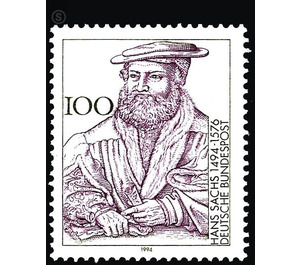500th birthday of Hans Sachs - Germany / Federal Republic of Germany 1994 - 100 Pfennig
Theme: Calender
| Country | Germany / Federal Republic of Germany |
| Issue Date | 1994 |
| Face Value | 100.00 |
| Color | white violet |
| Perforation | K 14 |
| Printing Type | 2-color Typography |
| Stamp Type | Postage stamp |
| Item Type | Stamp |
| Chronological Issue Number | 1636 |
| Chronological Chapter | GER-BRD |
| SID | 604583 |
| In 51 Wishlists | |
On the 5th of May, the fifth anniversary of the birth of the poet and master-singer Hans Sachs. When he died at the age of eighty-one he left behind a rich work of pianos, dramas, poems and prose dialogues on questions of his time. In the following centuries, however, his fame faded. Only in the course of the romantic movement, the post was rediscovered. Today's picture of Hans Sachs has been strongly influenced by Richard Wagner's opera »Die Meistersinger von Nürnberg«. Hans Sachs spent almost his entire life in Nuremberg. After attending the Latin school, he learned the shoemaking craft from Lienhard Nunnenbeck. However, before settling down with his own workshop and founding a family, he embarked on a journey that took him through Franconia and Bavaria to the Rhineland, as was then the case with a craftsman. Already in these years he had written first own seals. After settling in Nuremberg, he took up position for the Reformation in widely spread poems and therefore came into conflict with the City Council. However, this did not prevent him from continuing to speak critically in verse and prose about the political, religious and social issues of his time. The urban censorship was less severe in his plays, since they had less widespread effect. On simple stages - the theater in its present sense was in its earliest beginnings - cheerful banquets and carnival games in doggerel tricks delighted the urban public. However, Hans Sachs not only wanted to entertain, but he also pursued didactic intentions: In a vivid way, he stood up for tolerance and self-control by humorous exposing vice to people of all classes. His materials he borrowed from ancient, medieval and contemporary sources as well as the Bible. Goethe valued Carnival games so much that he staged the play "Fool-Schneyden" at the Weimar court. Through Richard Wagner's opera, Hans Sachs is best known today as a master singer, an art he had learned from his teacher Lienhard Nunnenbeck. In the southern German imperial cities craftsmen had joined together, who felt as successors of such famous medieval singer as Walther von der Vogelweide and put in singing schools their talents to the proof. The master songs had both spiritual and secular themes and were in the service of moral instruction. For the German language, these strictly regulated verses have become significant, as they made a significant contribution to the development of a uniform German standard language. The over 4,000 master songs by Hans Sachs are handed down in sixteen manuscript codices. The death of his wife Kunigunde triggered a serious crisis with the poet. His experiences with married life he had laid down in a spell poem whose verses inspired the image-maker Jürgen Weber to the 1984 built in Nuremberg "Marriage carousel fountain". The second marriage with a much younger widow spurred the now over sixty year old again. But at the beginning of the seventies, Hans Sachs retired from poetry. Shortly before his death, an oil painting of the poet, who dies on January 19, 1576, is created. (Text: Dr. Renate Hilsenbeck, Germanisches Nationalmuseum, Nuremberg)


